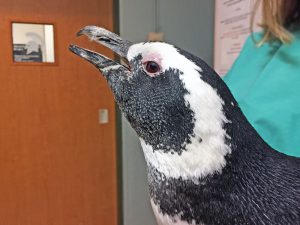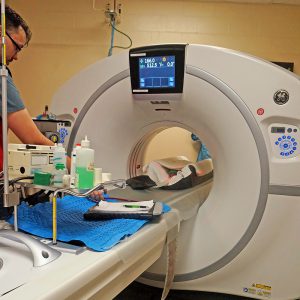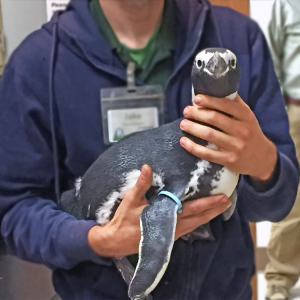
For the first time, the five Magellanic penguins of Potter Park Zoo in Lansing, Michigan travelled with Dr. Ronan Eustace, new veterinarian for the zoo, to the MSU Veterinary Medical Center for a routine health screening. The penguins and Potter Park veterinary team were welcomed by Dr. James Sikarskie, clinician for the Hospital’s Wildlife Service.
The physicals, which normally take place at the zoo, were conducted at the Hospital due to the need for advanced imaging. “We needed a clearer and more thorough look at the penguins’ internal organs, which is why they came to the Hospital for a CT procedure,” says Sikarskie.

While radiographs alone could be taken at the Potter Park Zoo, the Hospital’s computed tomography (CT) scanner, a GE Revolution EVP 64 Slice, can provide Sikarskie and Eustace with more detailed information regarding the penguins’ lungs, air sacs, stomachs, and other organs.
“Being able to see the internal structure and function of the penguins isn’t only an important aspect of their routine physicals, but it helps veterinarians maintain their health,” says Sikarskie. “With the CT scanner, we’re better able to see if the penguins have swallowed something that’s toxic to them, such as coins that visitors often throw into the pool that the penguins inhabit at the zoo.”
Coins contain materials that are toxic. Penguins explore using mouths, which means they use their beaks to pick up and ingest the coins. It’s almost impossible to know when penguins swallow coins because they continue to behave and eat normally. Fortunately, veterinarians who work with penguins understand this reality and risk, so they do whatever they can to mitigate it.

“The penguins’ annual physical is a testament to the lengths that Potter Park Zoo goes to take care of their animals,” says Sikarskie.
In addition to checking for coins, tests are run on the penguins’ bloodwork and fecal samples, and their hearts and lungs are listened to. “Just as it’s important for humans to go to the doctor for regular physicals, it’s important for animals, even penguins that live at the zoo, to get regular check-ups,” says Sikarskie. “Doing so enables doctors and veterinarians not only to keep their patients healthy but treat any health issues that may arise early on.”
Sikarskie has been involved with Potter Park Zoo for 43 years; from 1975–2005, he was the zoo’s only veterinarian. Since then, he’s held the role of backup veterinarian. “My relationship with the Potter Park Zoo is one that I’ve built and maintained for the benefit of the College’s students,” says Sikarskie. “It’s important for me to keep the local zoo as a resource for our students so they can experience working with exotics like they did when the penguins visited.”
